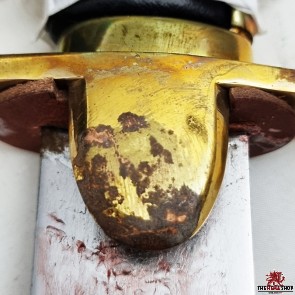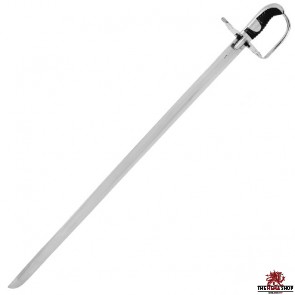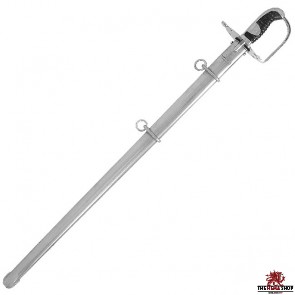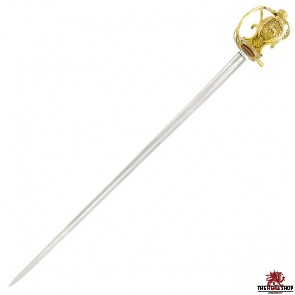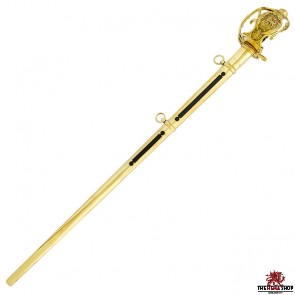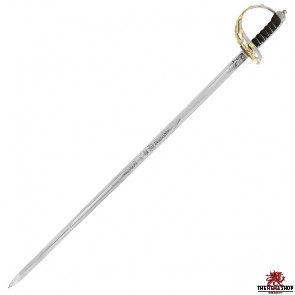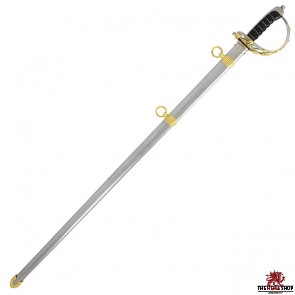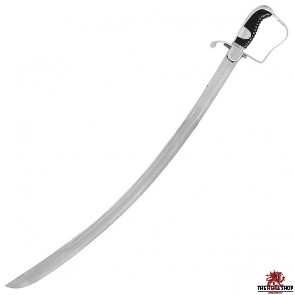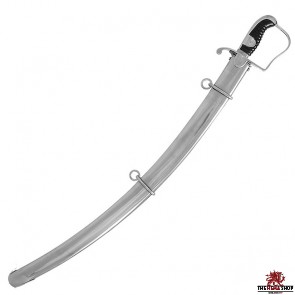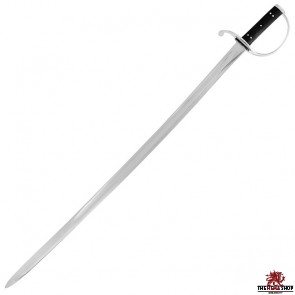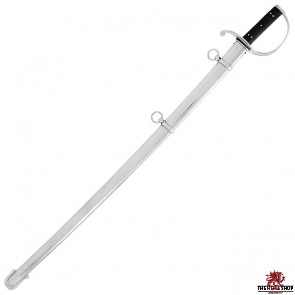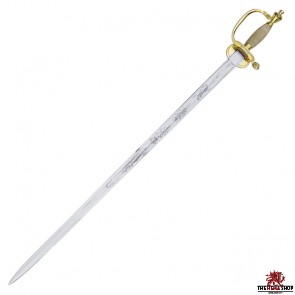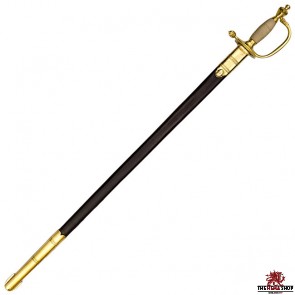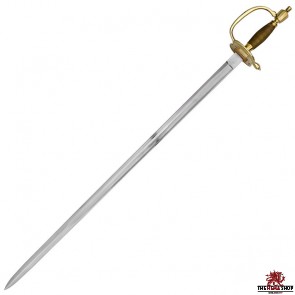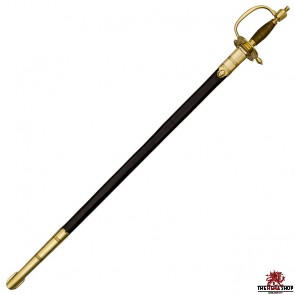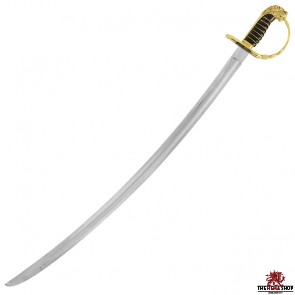Weapons
-
DAMAGED - British Royal Artillery Gunner's Sword
DAMAGE: Rust on hilt & guard
Learn More
Quantity: 1
This replica of the British Royal Artillery Gunners Sword has a blade forged from 1055 high carbon steel; replicated at the base of the spine are the manufacturer's markings as seen on an original example (DAWES BIRMM – William and Samuel Dawes of Birmingham). The hilt is crafted from brass and the wooden grip is bound in black leather. The sword is paired with a leather scabbard complete with a brass chape and locket.
This British Royal Artillery Sword was the sidearm of British Artillery crews in the early 1800s and these swords saw action in the Peninsular War, Waterloo, and the War of 1812. Unique for its wide and straight-bladed design, the sword was likely inspired by the French Imperial Guard Infantry Sword. The United States would borrow heavily from the design of this British sword when creating their own US Light Artilleryman's Saber during the War of 1812 which essentially was a marginally modified hilt design coupled with a curved saber blade.
Total Length: 78cm
Blade Length: 64cm
Handle Length: 11cm
Weight: 1270g
Blade Steel: 1055 High Carbon Steel
Blade Edge: Blunt
All dimensions are approximate and may vary from piece to piece.Regular Price: £175.00
Special Price Excl. Tax: £79.17 Incl. Tax: £95.00
-
British Heavy Cavalry Sword - 1796 Pattern
The 1796 Heavy Cavalry Sword was based on the Austrian 1775 pattern sword and was used by British Heavy Cavalry regiments such as the Dragoon Guards. The large blade had incredible cutting power but was cumbersome to use. It is perhaps most famous as the sword used by Richard Sharpe of the 95th Rifles in the series of books written by Bernard Cornwell.
Learn More
The polished blade has been forged from AISI 1065 High Carbon Steel and has been well tempered.
Replacement scabbard available separately
Total length: 102 cm
Blade length: 89 cm
Grip length: 9.5 cm
Weight: 1.266 kg
Blade thickness (base): 7.3 mm
Blade thickness (CoP): 5 mm
Blade width (base): 3.4 cm
Blade width (CoP): 3 cm
Point of Balance (PoB): 20 cm
Centre of Percussion (CoP): 21 cm
Blade: AISI 1065 High Carbon Steel
Edge: Blunt
Pommel: Peened
Scabbard: Steel
All dimensions are approximate and may vary from piece to piece.Excl. Tax: £183.33 Incl. Tax: £220.00 -
Household Cavalry Officer's Sword - 1814 Pattern
The Household Cavalry consists of the 2 most senior regiments in the British Army regiments, the Life Guards and the Blues and Royals. They were present at some of the British Army’s most notable battles, including Waterloo, where this sword would have seen action during the Charge of the Heavy Brigade.
Learn More
The styling of the Household Cavalry Officers Sword borrows much from the Prussian military ‘’Pallasch’’ swords. It features a tempered high-carbon steel blade inscribed with a “HAMBURGER & Co” makers mark to replicate an original. The ornate brass hilt encloses a leather wrapped wooden grip with twisted brass wire overlay. The wooden scabbard is covered with black leather and features an integrated brass sheath with brass hanging rings.
Total length: 110cm
Blade length: 96cm
Grip length: 9.5cm
Weight: 1550g
Blade thickness (base): 0.8cm
Blade width (base): 3.2cm
Point of Balance (PoB): 17cm
Blade: AISI 1065 High Carbon Steel
Edge: Blunt
Pommel: Peened
Scabbard: Leather, Wood, Brass
All dimensions are approximate and may vary from piece to piece.Excl. Tax: £208.33 Incl. Tax: £250.00 -
British Household Cavalry Sword - 1834 Pattern
After the Crimean War there were many changes made within British Heavy Cavalry Regiments. One of these changes was the adoption of a variation of the 1st Life Guards Sword by the 2nd Life Guards. This sword served throughout the Boer War and WWI until the regiments were amalgamated in 1922. It still serves today as the official state sword of the Life Guards. The polished blade has been forged from EN9 steel and has been well tempered.
Learn More
Total length: 116 cm
Blade length: 99.5 cm
Grip length: 11 cm
Weight: 1.202 kg
Blade thickness (base): 7.4 mm
Blade thickness (CoP): 5.5 mm
Blade width (base): 3 cm
Blade width (CoP): 2.5 cm
Point of Balance (PoB): 21 cm
Centre of Percussion (CoP): 30 cm
Blade: AISI 1065 High Carbon Steel
Edge: Blunt
Pommel: Peened
Scabbard: Steel, Brass
All dimensions are approximate and may vary from piece to piece.Excl. Tax: £183.33 Incl. Tax: £220.00 -
British Light Cavalry Sabre - 1796 Pattern
Famed for its use by Britain’s Light Dragoons and Hussars during the Peninsular War and Waterloo, this sword was also supplied to the Prussian Cavalry in great numbers and even found favour in the USA.
Learn More
This design was suggested for British service by cavalry officer John Gaspard Le Marchant, who believed cavalry swords should be light and have a curved, slashing blade. The long curved blade has been forged from AISI 1065 High Carbon Steel and has been well tempered.
Replacement scabbard available separately
Total length: 96 cm
Blade length: 83 cm
Grip length: 9.5 cm
Weight: 1.078 kg
Blade thickness (base): 6 mm
Blade width (base): 3.4 cm
Point of Balance (PoB): 22 cm
Blade: AISI 1065 High Carbon Steel
Edge: Blunt
Pommel: Peened
Scabbard: Steel
All dimensions are approximate and may vary from piece to piece.Excl. Tax: £208.33 Incl. Tax: £250.00 -
British Cavalry Sword - 1853 Pattern
The 1853 Pattern British Cavalry Sword was introduced during the Crimean War and saw service at the Battle of Balaclava – most notably during The Charge of the Light Brigade where the Russian gunner’s great coats proved to withstand all but the sharpest of blades but fell to the thrusts of the British cavalrymen.
Learn More
This sword was also the first to be issued to both Light and Heavy Cavalry regiments. The polished blade has been forged from AISI 1065 High Carbon Steel and has been well tempered.
Total length: 104 cm
Blade length: 90 cm
Grip length: 12 cm
Weight: 1.124 kg
Blade thickness (base): 7.9 mm
Blade thickness (CoP): 4 mm
Blade width (base): 3.2 cm
Blade width (CoP): 2.6 cm
Point of Balance (PoB): 18 cm
Centre of Percussion (CoP): 30 cm
Blade: AISI 1065 High Carbon Steel
Edge: Blunt
Pommel: Peened
Scabbard: Steel
All dimensions are approximate and may vary from piece to piece.Excl. Tax: £165.83 Incl. Tax: £199.00 -
British Infantry Officer's Sword - 1796 Pattern
This replica of the 1796 British Infantry Officer sword has a blade of unsharpened, tempered high carbon steel. Both sides of the blade feature the embossed cyper of the British Crown surmounted extensively by royal devices and floral motifs.
Learn More
It has a hilt of brass and a grip wrapped in copper wire that is plated with silver. Half of the guard is hinged and folds for ease of carry at the hip. The scabbard is of leather with brass accents.
Total length: 95cm
Blade length: 80cm
Grip length: 6.5cm
Weight: 784g
Blade thickness (base): 0.7cm
Blade width (base): 2.5cm
Point of Balance (PoB): 31cm
Blade: AISI 1065 High Carbon Steel
Edge: Blunt
Pommel: Nut
Scabbard: Leather, Wood, Brass
All dimensions are approximate and may vary from piece to piece.Excl. Tax: £187.50 Incl. Tax: £225.00 -
British Infantry Officer's Sword - 1796 Pattern
When the British Army standardized the swords to be carried by infantry officers in 1796 this is the sword they settled on; a spadroon-like cut-and-thrust sword with simple, but elegant Georgian styling that hearkened back to the Smallswords carried by gentlemen in earlier times. In just four years following, the blade was at the hip of practically all British Line Infantry Officers. Regardless of the standardization of form, the blades varied in their width and in their engraved decoration.
Learn More
Though widespread, it was not regarded as a good combat blade despite being used through the entirety of Britain’s contests with France in the Napoleonic Era. It would not be officially replaced until 1822 by the more elaborate ‘’Gothic-Hilted’’ sword and before then many officers had opted to acquire the 1803 Pattern sabre instead.
Total length: 100cm
Blade length: 85cm
Grip length: 6cm
Guard width: 9.5cm
Weight: 946g
Blade thickness (base): 0.6cm
Blade width (base): 2.5cm
Point of Balance (PoB): 33cm
Blade: AISI 1065 High Carbon Steel
Edge: Blunt
Pommel: Nut
Scabbard: Leather, Wood, Brass
All dimensions are approximate and may vary from piece to piece.Excl. Tax: £208.33 Incl. Tax: £250.00 -
British Sergeant Sword - 1796 Pattern
This recreation of the British 1796 Sergeant’s sword has a plain blade of unsharpened, tempered, high carbon steel. The hilt is entirely of brass. The scabbard is of leather with brass accents.
Learn More
The sword is the longer version used by the sergeants instead of the shorter blade used by the musicians, though the overall sword design and construction were inherently the same.
Total length: 95cm
Blade length: 80cm
Grip length: 9cm
Weight: 882g
Blade thickness (base): 0.6cm
Blade width (base): 2.5cm
Point of Balance (PoB): 32cm
Blade: AISI 1065 High Carbon Steel
Edge: Blunt
Pommel: Nut
Scabbard: Leather, Wood, Brass
All dimensions are approximate and may vary from piece to piece.Excl. Tax: £187.50 Incl. Tax: £225.00 -
British Flank Infantry Officer's Sabre - 1803 Pattern
This sabre was introduced in 1803 and proved a popular replacement for the 1796 Infantry Sword. It was readily adopted by Light Infantry and Rifle Officers who were much more likely to skirmish with the enemy than their Line Infantry counterparts. The design proved popular and it was adopted by flank companies of the Royal Marines and some Royal Navy officers as well.
Learn More
The polished blade has been forged from AISI 1065 High Carbon Steel and has been well tempered.
Total length: 94.5 cm
Blade length: 82 cm
Grip length: 8 cm
Weight: 1.102 kg
Blade thickness (base): 7.5 mm
Blade width (base): 3 cm
Point of Balance (PoB): 20 cm
Blade: AISI 1065 High Carbon Steel
Edge: Blunt
Pommel: Peened
Scabbard: Leather, Wood, Brass
All dimensions are approximate and may vary from piece to piece.Excl. Tax: £187.50 Incl. Tax: £225.00




